The Oz Goose was love at first sight. Or was it finding a love lost? There is something wonderful about sailing a light, responsive boat. I grew up in The Netherlands in the 1970s and spent all my spare time sailing my 8′ dinghy. Since then, I’ve sailed and often raced dinghies and yachts in many countries, on seas and ocean. But the thing that got me into sailing was the response of a light boat, the chuckle of the water at the bow, and the pride of sailing a boat that was actually mine. Fifty years later, I am as hooked on my Oz Goose as I was on that first dinghy.
The Oz Goose is a squarish plywood sailing dinghy measuring 12′ long and 4′ 2″ wide. The “Oz” in its name indicates the nationality of the designer, Michael Storer, who hails from Australia. The Oz Goose is one of the many boats inspired by the Bolger Brick. The pilot version of the Goose was 8′ long and 4.2′ wide; later versions were the current size, 12′ by 4′ 2″. Only a handful of prototypes were built, but in 2014, when Texan sailor Ian Henehan started posting videos of an early Goose planing up to 12 knots in moderate wind, the design drew sailors’ attention around the world. It even surprised Michael that his “experiment” could sail so fast and so well. A MK2 version was developed, with a simplified construction method that made the boat lighter. With new plans available, the Oz Goose soon appeared in Europe, North America, Asia, and Australia. The Oz Goose fleet and community grew quickly through Family Boatbuilding Weekends, when families and community groups can build boats for themselves in just a few days. Sailing clubs popped up; I joined one that regularly brings together more than 20 Oz Goose boats to sail for fun and competitive events.
The plans come in the form of a 115-page manual illustrated with color photographs and a wealth of drawings. Measured drawings provide the shapes of the plywood pieces and the easy-to-follow instructions cover almost everything in detail. In addition to the instructions provided for the standard timber-framed construction, there are clearly marked directions for those who prefer to use fillets of thickened epoxy at the intersections of the panels; filleted joints can save time and may be cheaper. The build doesn’t require many tools: pencils and measuring tapes, a cordless drill/screwdriver to put in temporary screws, a jigsaw, and a hand plane. A random-orbit sander speeds finishing work. When we encountered problems, the Goose Facebook group proved very useful with detailed answers in a few hours or overnight, and there are now also some excellent YouTube videos with coverage of specific sections of the building process. Just search for “Oz Goose sailboat construction.”
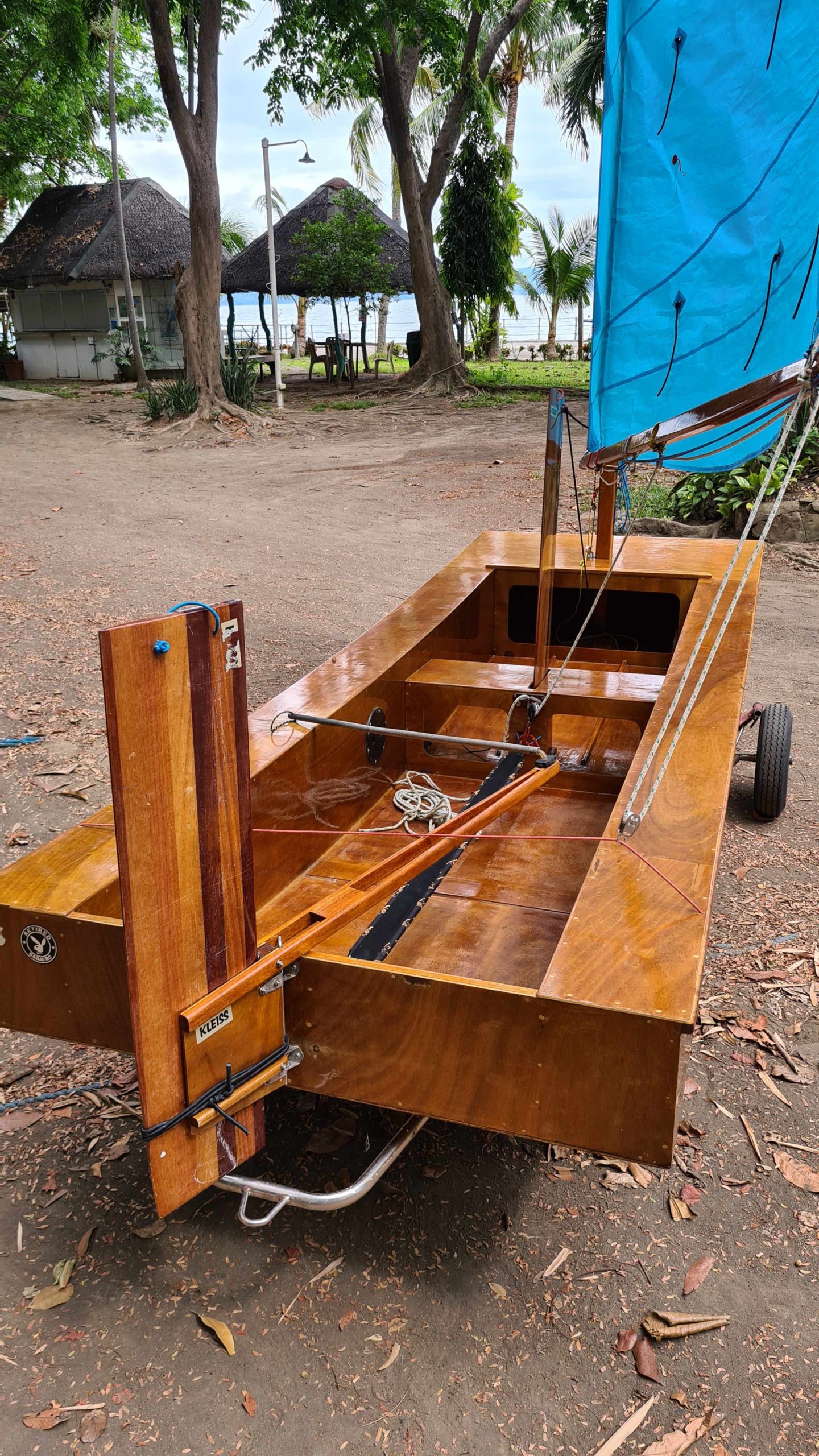 Photographs courtesy of the author
Photographs courtesy of the authorThe Oz Goose layout is as simple as it gets. Both the rudder and daggerboard are retracted here, the daggerboard in its trunk and the rudder in its open-backed box with a bungee holding it in place.
The rectangular shape of the boat makes it simple to mark out and cut its components. Only the 12′-long hull sides and the flotation tank sides have curves—sheer and chine—and they are all identical so only two curves have to be drawn and faired. The rest of the parts are straight-sided rectangles.
The Oz Goose is laid out around two full-length buoyancy tanks that form the cockpit sides and side decks. In the middle of the boat is the daggerboard trunk, instead of a centerboard trunk. It simplifies construction and maximizes cockpit legroom. The rudder blade is held by a ¼″ shock cord in an open-backed box. It can be set at any height and provides light and accurate steering in any depth of water. If the blade strikes an obstacle it swings back and, after passing over, snaps back down again.
The daggerboard and rudder are given foil cross-sections using the templates provided in the manual and scaled online by the designer. Especially for racing, it is most important to shape them accurately and keep them in good condition.
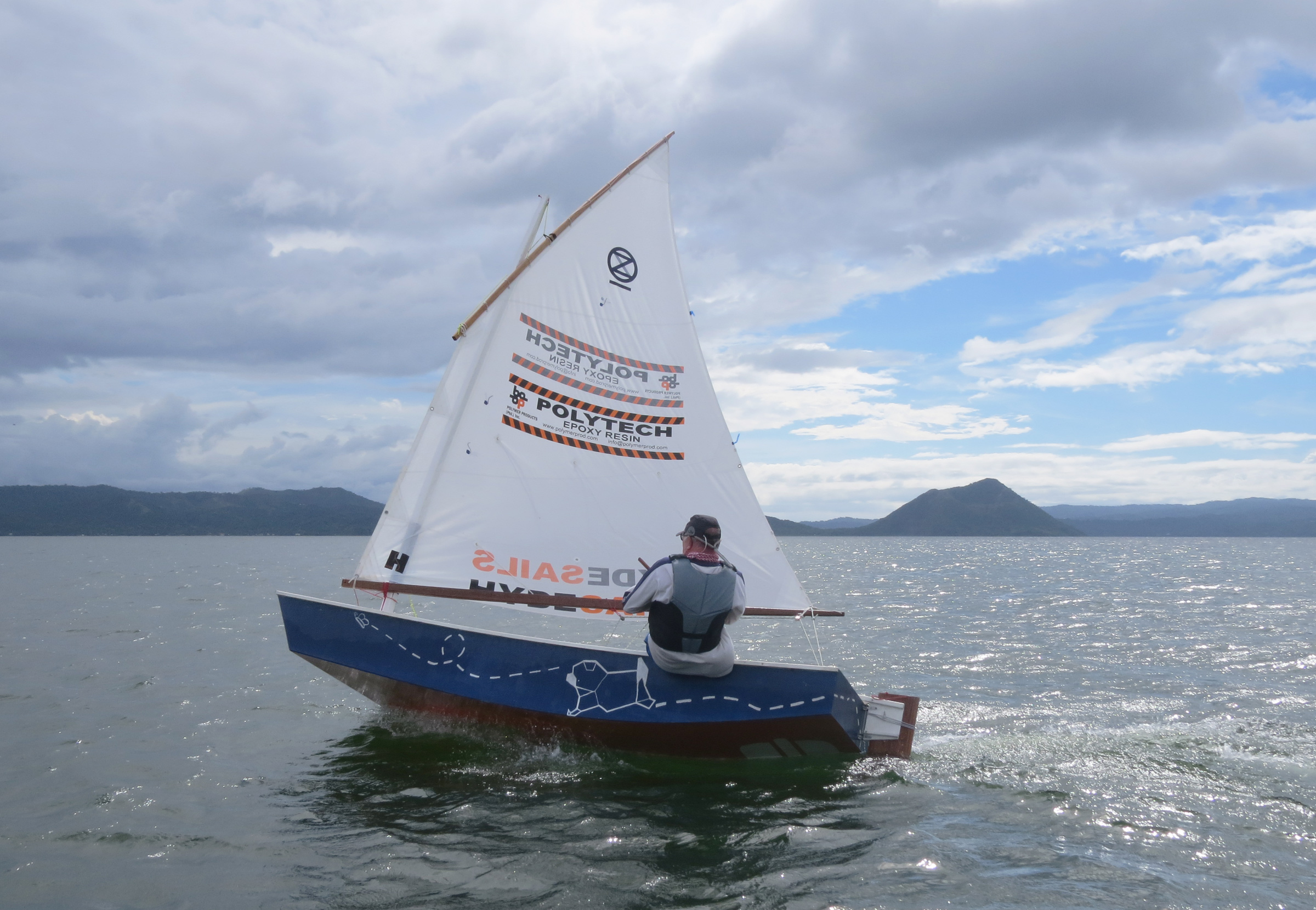
When an Oz Goose heels, much of the flat-bottomed hull rises above the water which significantly reduces the wetted surface area, adding to the potential for speed.
The 13 1/4′ tapered mast has a hollow box; the detailed instructions make it easy to build. The manual includes instructions for making the 11′ boom either hollow or solid. The 10 ½′ yard is solid. The Oz Goose flies an 89-sq-ft balance lugsail. Several measured drawings for making the sail are provided. For those who prefer a sail less expensive than custom-made or sewn at home, there are instructions for making the sail from a poly tarp and double-sided tape. Commercial sails for the Goose typically have two reefs.
Fittings for the rigging are simple and straightforward. For such a high-performance boat, the hardware list is tiny: three simple blocks, one horn cleat, and some rudder hardware. You can opt to have an adjustable downhaul and outhaul by purchasing and installing additional hardware, but rules for the Oz Goose class don’t allow racers to make adjustments with such devices during a race, so rich and poor are on an equal playing field.
Working evenings, odd days and weekends, it took me around two months to build the boat. A group on Facebook indicated building times from around one to perhaps six months. With the cost of materials relatively low here in the Philippines, our self-built boat cost under US$1,000. In North America, the cost of the boat, sails, and fittings, may come to about $2,000.
At 110 to 130 lbs, the Goose is light enough for two adults to carry to the beach or place on a roof rack. The boat can be sailed solo or with a crew member, for casual sailing or racing. The Goose even has space in its cockpit to fit three people and in light wind it still sails fine, even with those three aboard.
Senior sailors find it less taxing to move about in the ample, uncluttered cockpit and will enjoy the Goose more than other small dinghies. There are several disabled people who have also taken to sailing the Goose, reassured by its high stability. If you do manage to capsize a Goose, the buoyancy provided by the side tanks will let you bring the boat upright by using the daggerboard as a lever, and the cockpit won’t take on any water.
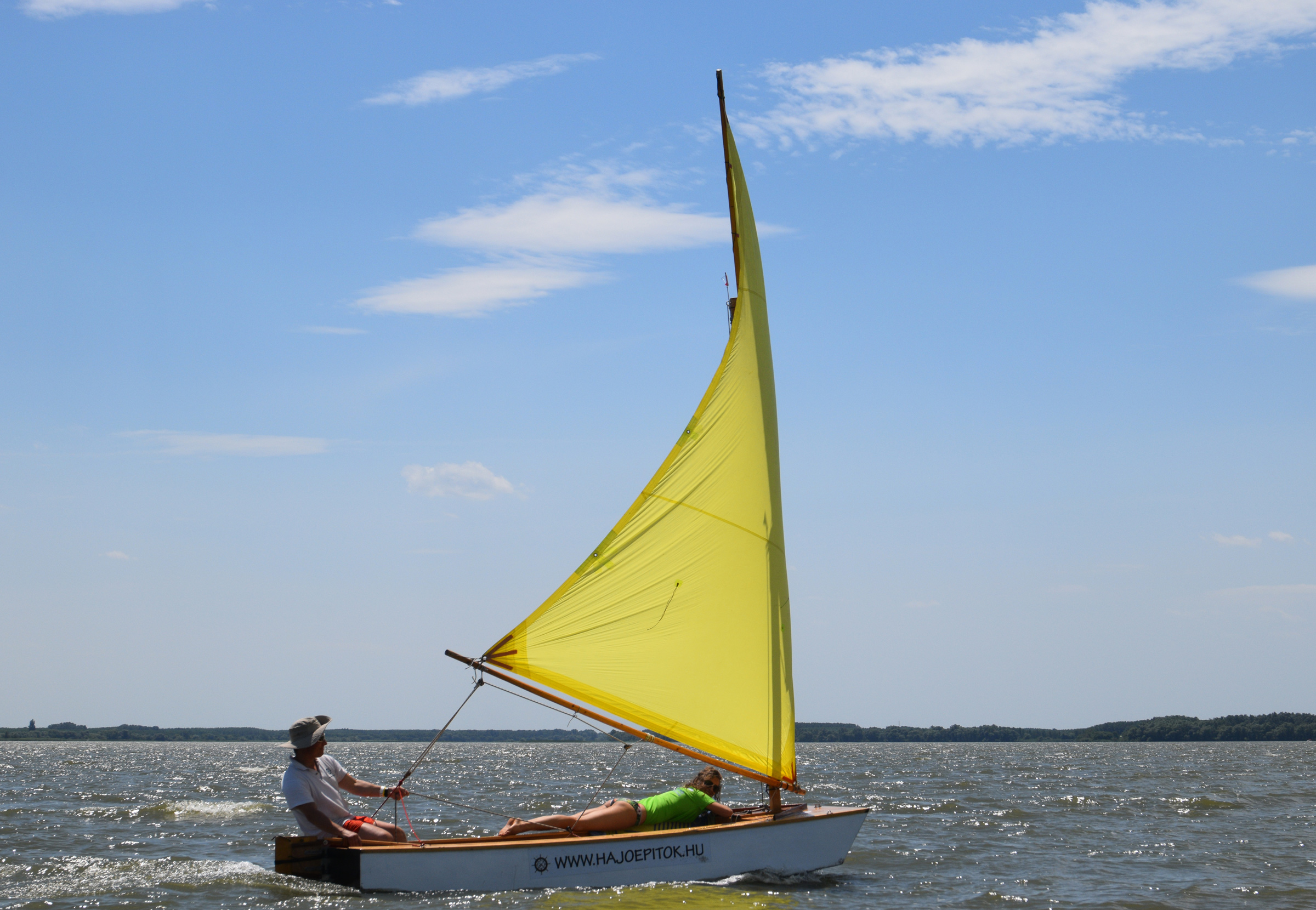
The popularity of the Oz Goose got a significant boost from videos of it sailing at high speed, but it was initially developed for sail training and family outings.
In light winds, you might normally sit well forward while going upwind, but with the Goose, the square bow needs to be out of the water or you will be plowing the waves like a bulldozer. The boat comes alive once the right trim has been achieved, and very little water ends up on the foredeck. When the wind picks up, and especially when bigger waves are building, we sometimes sit really far back. Sailing on a reach is easier, and the helm and crew position are essential to keeping the boat level and getting it to plane, which is a rewarding experience in a Goose. It loves to plane and the transition from displacement mode to planing is hardly noticeable. When sailing with two, it is important that they sit right beside each other in that correct location to squeeze out the best performance from the boat. And with two, the Oz Goose sails at the same speed as singlehanded boats, allowing for fleet races with mixed crews, including adult/child, adult/teen, two teens, two adults, and solo sailors.
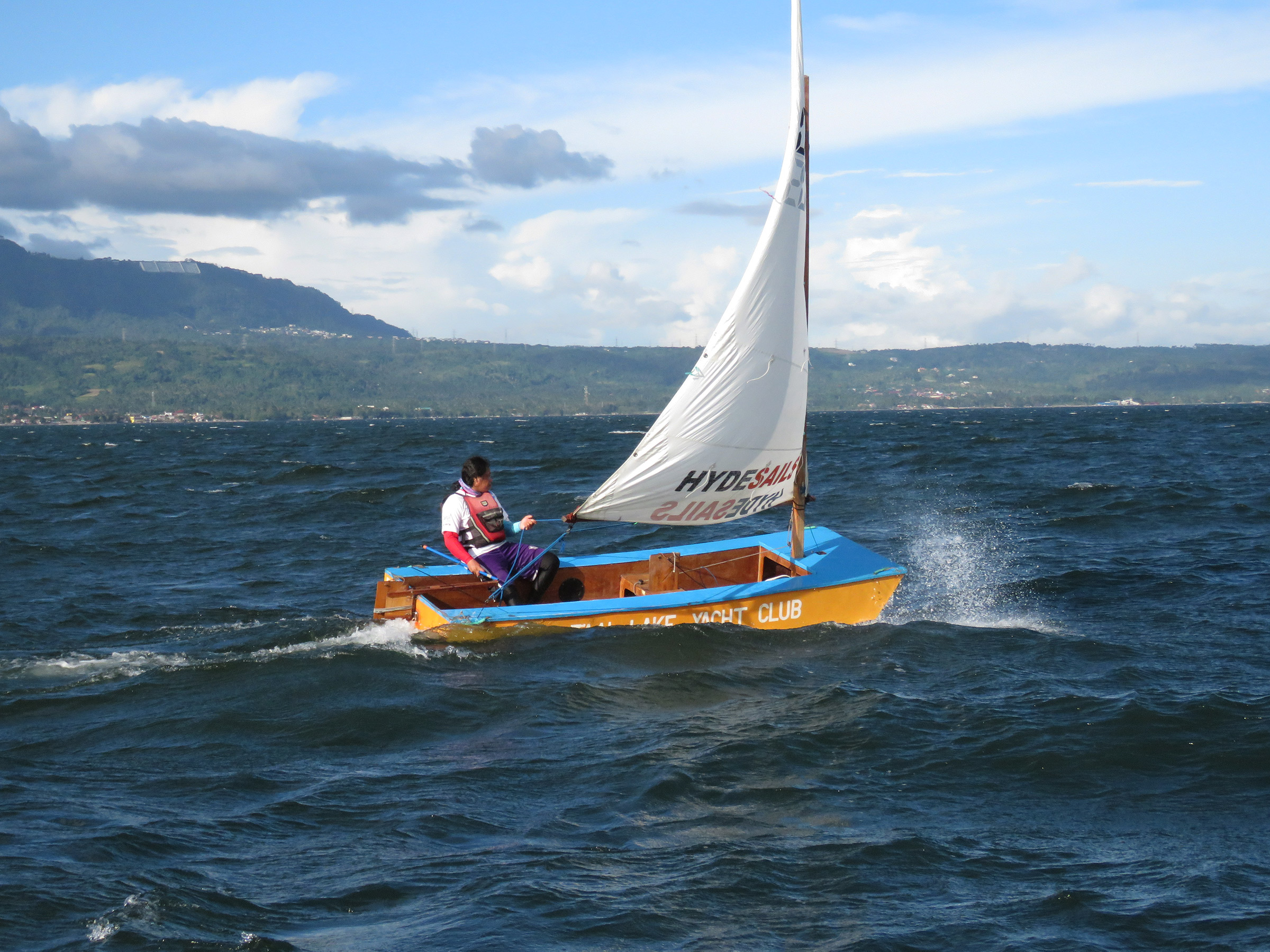
When the wind and waves are up, shifting the crew weight aft keeps the bow high and the ride dry.
Even with a double reef in heavy wind, the boat sails remarkably well and is controllable on all points of sail. One needs to be proactive with the sheet—keep it in hand. In gusts, a common reflex would be to steer the boat higher while relaxing the main just a bit but, in my experience, in a Goose it is better to bear down and release the main quite a bit to keep the boat flat and maintain speed. As soon as the wind allows it, I will pull the sheet in, then steer back on course.
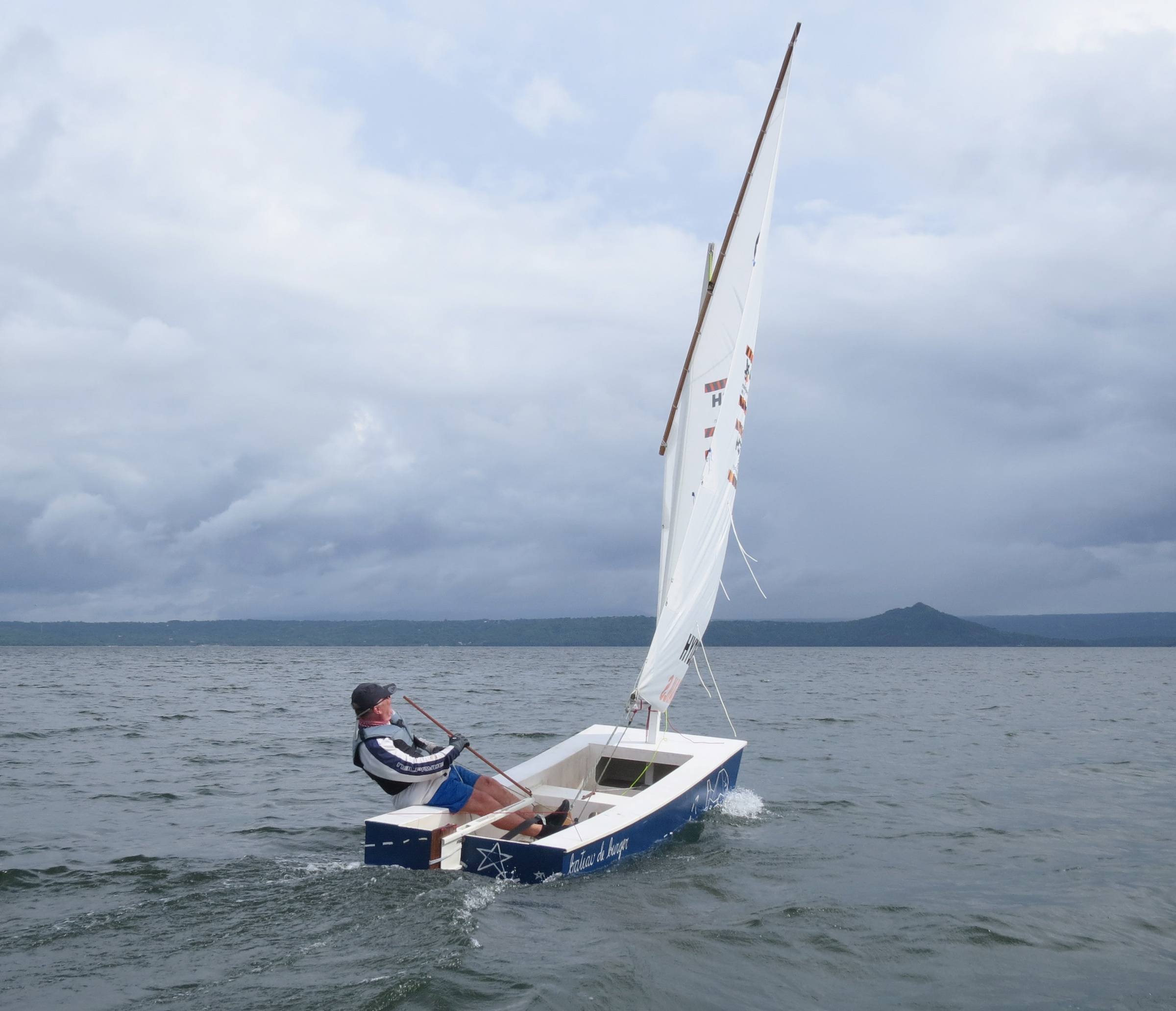
Contrary to expectations, the lugsail performs better when the sail is to windward of the mast and creased by it.
With the sail either on the downwind or upwind side of the mast, there is sometimes a very different feel on opposite tacks, especially right after coming about. We have found that neither port-rigged nor starboard-rigged boats will lose out when sailing side by side. Interestingly, our “Geesers” have found that the supposed “bad tack” of the lug has been wrongly attributed to having the sail on the windward side of the mast; it is actually the opposite. When the sail presses against the mast, acceleration is instantaneous after tacking. On the opposite tack, when the mast does not contact the sail, it is harder to find the speed and angle combination. The trick is to find the same speed as on the other tack before trying to point high. Being too greedy by pointing high before finding speed will fly back in your face.
In the absence of waves and with light to moderate winds, the Goose will glide over the water not like a goose, but like a swan. The speed and ease of sailing under those conditions is just awesome. I find owning and operating a Goose very thrilling. Having been a Laser sailor a big part of my life, I am still surprised by how well this dinghy sails under all conditions. Racing a Goose is highly competitive and rewarding, and the entire vision behind it will make sailing very affordable in most economies and communities. ![]()
Thom Kleiss was born on the water, on a houseboat in The Netherlands, and has been sailing since the age of four. Now living in Ireland and the Philippines, water is never far away. He is passionate about dinghy sailing development, is the Commodore of the Bere Island Watersports Club in Ireland, and is active in senior Laser racing in Singapore and Oz Goose sailing development in Taal Lake Yacht Club in the Philippines.
Oz Goose Particulars
[table]
Length/ 12′
Beam/ 4′ 2″
Weight/ 125 lbs
Sail area/ 89 sq ft
[/table]
For more information about the Oz Goose, see Michael Storer’s website. To purchase plans, see his list of agents. In the U.S., plans are available from Duckworks: $40 for PDF format, $75 for print. Duckworks offers several Oz Goose kits, prices vary. Precut plywood kits are available in the Americas, Australasia, Philippines, Africa, and Europe.
Is there a boat you’d like to know more about? Have you built one that you think other Small Boats Magazine readers would enjoy? Please email us!
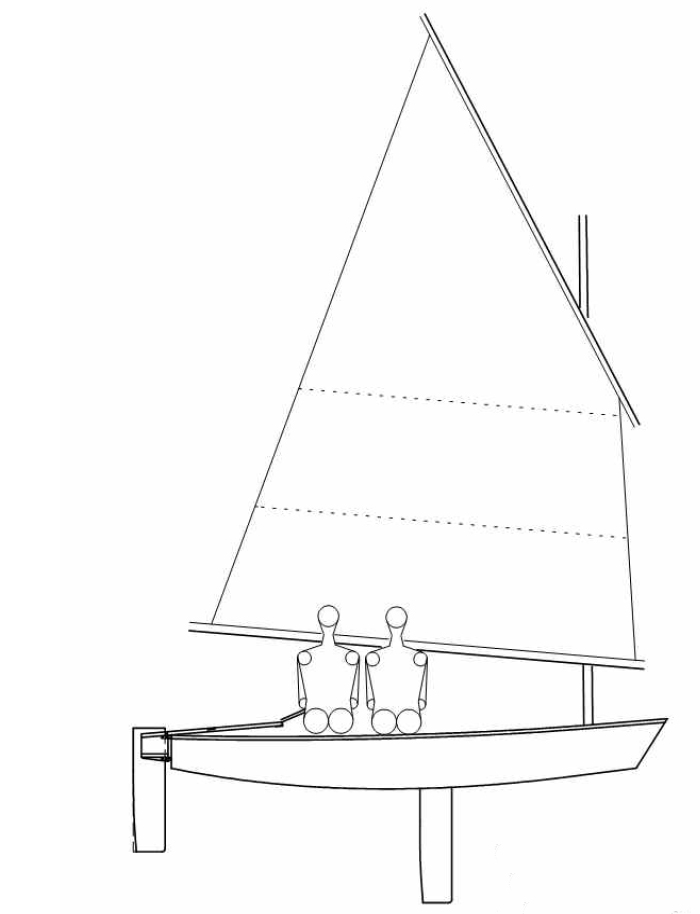
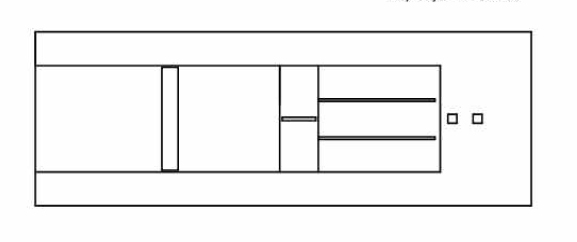
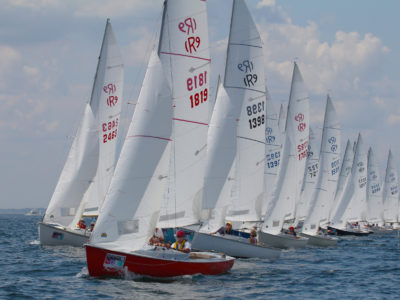
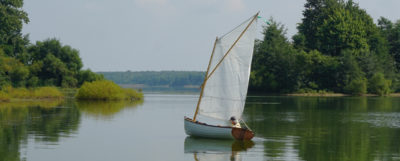
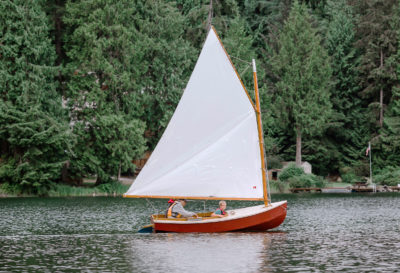
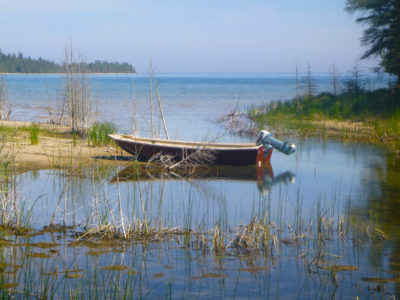
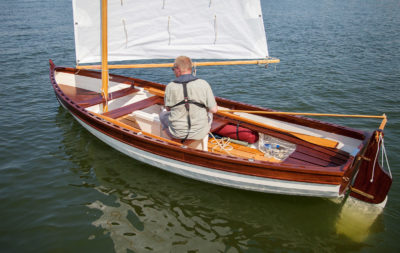

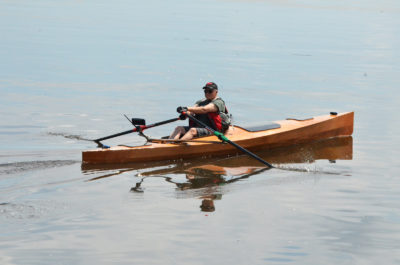
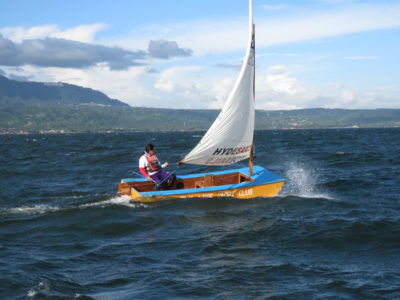
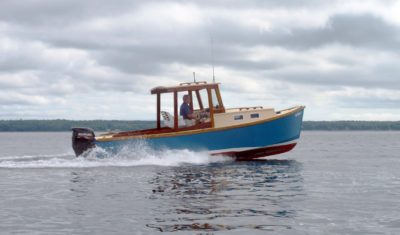
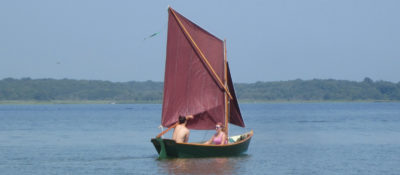
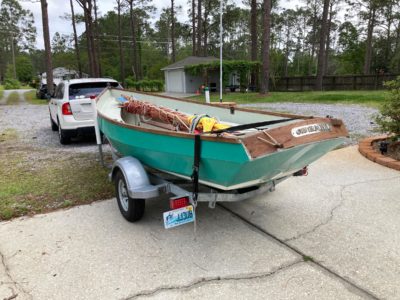
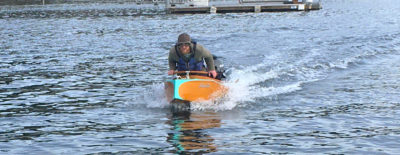
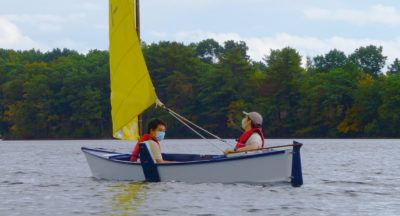
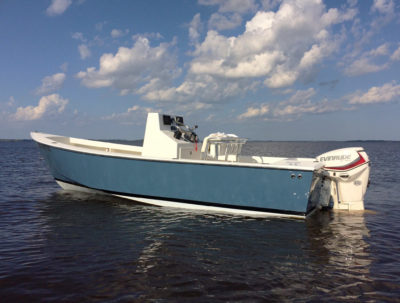
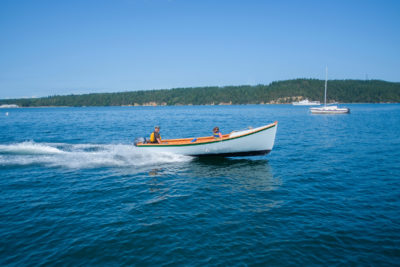
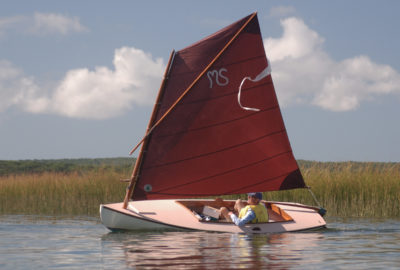
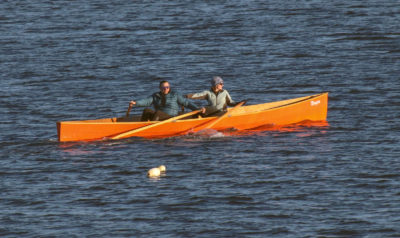
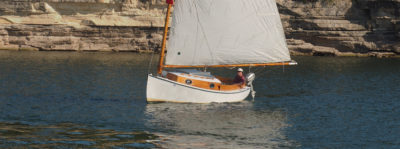
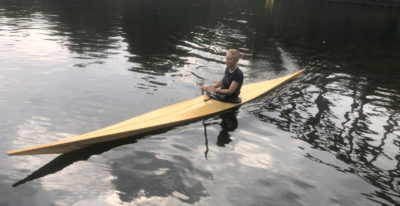
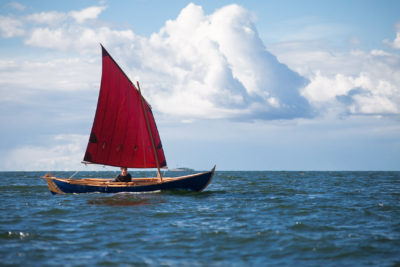
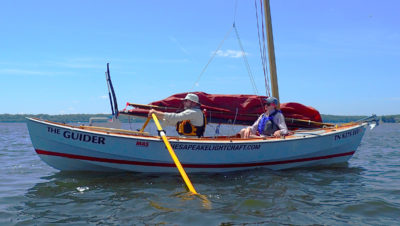
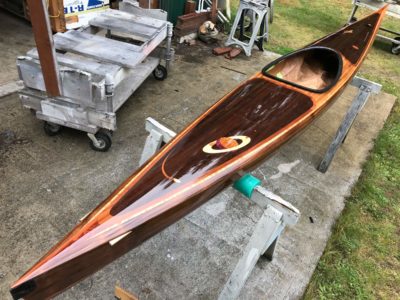
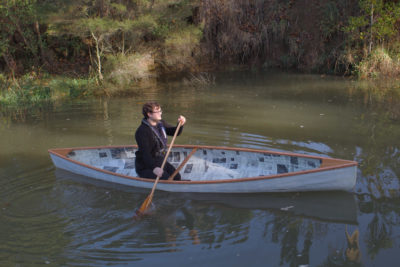
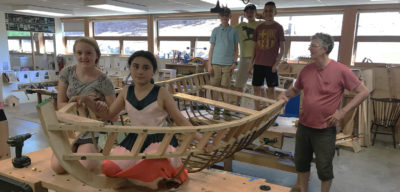
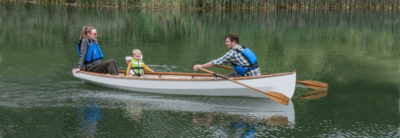
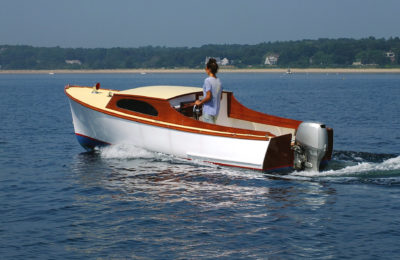
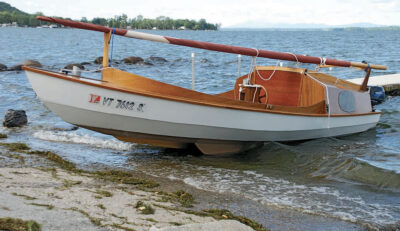
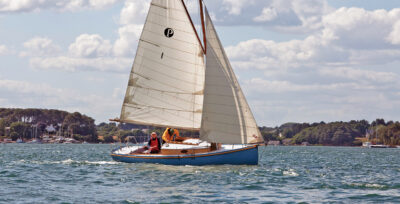
Thank you for putting this article together, Chris and team.
Also a big thanks to Thom Kleiss. I had the pleasure to sail in company with him several times—he even beat me in some of our regular races. He has just departed the Philippines with his beautiful varnished Oz Goose (the one with blue sail in the article) in a huge plywood box being shipped to Ireland.
We were joking that the box would make an amazing MEGA Goose with a bit of added rocker!
Michael Storer
I love your article. I sail an East port Pram. It has a bit of a rocker. I would intersted in seeing the MEGA as I need room to add a cubby and sleep on board.
Cheers
That version has been designed. See Duckworks for the Goose Explorer.
Very interesting observations about the supposed “bad tack” of the balanced lug rig. I noticed the same thing on my old Caledonia Yawl: the bad tack was better up wind than the good tack.
Following up on the “bad tack” surprising phenomenon, I wonder what would be the affect of putting the daggerboard slot to one side or the other. It would open up a lot of space.
See Michael Storer’s website.
Bolger insisted that boats don’t notice an off-center board, nor an off-center rig. Your idea should work fine.
I have a 4.4 m flat-bottomed paulownia sailboat with a 1.01 m wide bottom and 7 square metres of sail area. The sail is a spritsail made by Really Simple Sails (Michael Storer).
If I can find a place within 50 km of Munich to build his Oz Goose over the coming winter, I will order the plans from Michael.
I will build the boat with 18 mm paulownia wood. It will barely weigh more than if it were built of 6 mm plywood—however, but I don’t consider that increase significant, as it will still weighs less than 60 kg.
What appeals to me about the boat is the strong upward sweep aft, which creates a supercritical negative pressure in the flow. In a narrow or round bottom, the pressure gradient would be reduced, but with a beam of 1.2 m, no gradient towards the sides, and no prismatic tapering, this pressure gradient remains. And if the transom edge is then very(!) sharp, the pressure gradient manifests itself there in the absorption of air. Equalization is achieved and it foams… I would like to experience that.
What’s more, my lightweight wife always loved lying on her stomach on the foredeck on one of my previous boats and letting her red hair fly, even when there was a lot of wind. Today, her hair is no longer red, but she misses that feeling. And, at 73, I’m old enough to enjoy a boat with good initial stability, which I can easily get back into after capsizing and then hardly have any water in the boat. I think the Oz Goose will satisfy both our needs.
Now I just need to find a place to build the boat near Munich.
Best – Dieter